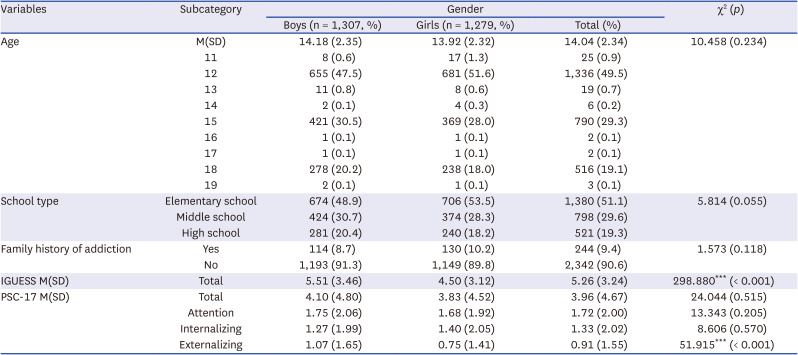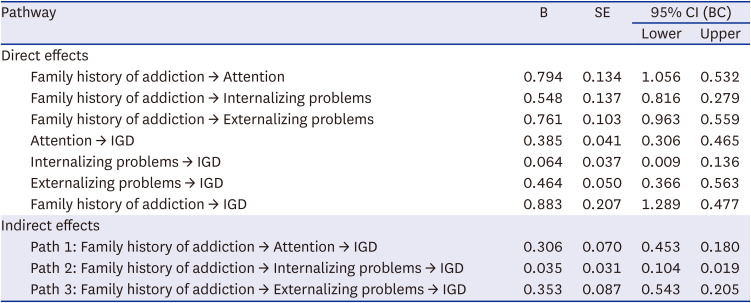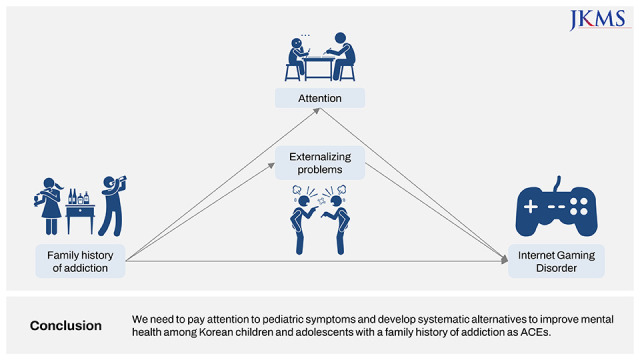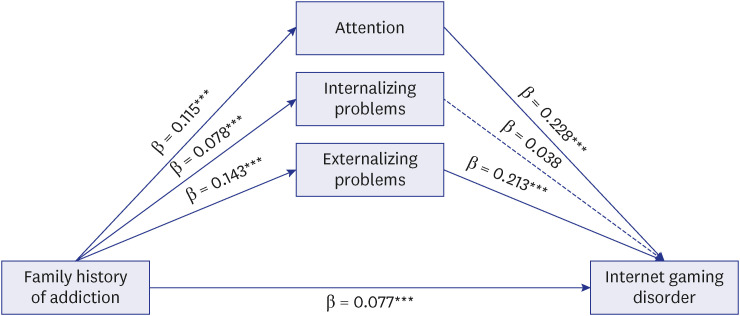1. Effatpanah M, Moharrami M, Rajabi Damavandi G, Aminikhah M, Hosein Nezhad M, Khatami F, et al. Association of internet addiction with emotional and behavioral characteristics of adolescents. Iran J Psychiatry. 2020; 15(1):55–66. PMID:
32377215.
2. Moreno MA, Kerr BR, Jenkins M, Lam E, Malik FS. Perspectives on smartphone ownership and use by early adolescents. J Adolesc Health. 2019; 64(4):437–442. PMID:
30389204.
3. Hsieh YP, Chou WJ, Wang PW, Yen CF. Development and validation of the parents’ perceived self-efficacy to manage children’s internet use scale for parents of adolescents with attention-deficit/hyperactivity disorder. J Behav Addict. 2017; 6(4):593–600. PMID:
29076356.
4. Kwon M, Lee JY, Won WY, Park JW, Min JA, Hahn C, et al. Development and validation of a smartphone addiction scale (SAS). PLoS One. 2013; 8(2):e56936. PMID:
23468893.
5. Bernardi S, Pallanti S. Internet addiction: a descriptive clinical study focusing on comorbidities and dissociative symptoms. Compr Psychiatry. 2009; 50(6):510–516. PMID:
19840588.
6. Ko CH, Yen JY, Chen CC, Chen SH, Yen CF. Gender differences and related factors affecting online gaming addiction among Taiwanese adolescents. J Nerv Ment Dis. 2005; 193(4):273–277. PMID:
15805824.
7. Porter G, Starcevic V, Berle D, Fenech P. Recognizing problem video game use. Aust N Z J Psychiatry. 2010; 44(2):120–128. PMID:
20113300.
8. Wölfling K, Beutel ME, Dreier M, Müller KW. Bipolar spectrum disorders in a clinical sample of patients with Internet addiction: hidden comorbidity or differential diagnosis? J Behav Addict. 2015; 4(2):101–105. PMID:
26132914.
9. Association AP. Diagnostic and Statistical Manual of Mental Disorders (DSM-5). Arlington, VA, USA: American Psychiatric Association;2013.
10. Darvesh N, Radhakrishnan A, Lachance CC, Nincic V, Sharpe JP, Ghassemi M, et al. Exploring the prevalence of gaming disorder and internet gaming disorder: a rapid scoping review. Syst Rev. 2020; 9(1):68. PMID:
32241295.
11. Petry NM, Rehbein F, Gentile DA, Lemmens JS, Rumpf HJ, Mößle T, et al. An international consensus for assessing internet gaming disorder using the new DSM-5 approach. Addiction. 2014; 109(9):1399–1406. PMID:
24456155.
12. Jo YS, Bhang SY, Choi JS, Lee HK, Lee SY, Kweon YS. Clinical characteristics of diagnosis for internet gaming disorder: comparison of DSM-5 IGD and ICD-11 GD diagnosis. J Clin Med. 2019; 8(7):945. PMID:
31261841.
13. Fazeli S, Zeidi IM, Lin CY, Namdar P, Griffiths MD, Ahorsu DK, et al. Corrigendum to “Depression, anxiety, and stress mediate the associations between internet gaming disorder, insomnia, and quality of life during the COVID-19 outbreak” [Addict. Behav. Rep. 12 (2020) 100307]. Addict Behav Rep. 2020; 12:100322. PMID:
33364329.
14. Tafur-Mendoza AA, Acosta-Prado JC, Zárate-Torres RA, Ramírez-Ospina DE. Assessing the psychometric properties of the internet addiction test in Peruvian university students. Int J Environ Res Public Health. 2020; 17(16):5782. PMID:
32785063.
15. Yen CF, Chou WJ, Liu TL, Yang P, Hu HF. The association of Internet addiction symptoms with anxiety, depression and self-esteem among adolescents with attention-deficit/hyperactivity disorder. Compr Psychiatry. 2014; 55(7):1601–1608. PMID:
25015304.
16. Zamboni L, Portoghese I, Congiu A, Carli S, Munari R, Federico A, et al. Internet addiction and related clinical problems: a study on Italian young adults. Front Psychol. 2020; 11:571638. PMID:
33240160.
17. Matar Boumosleh J, Jaalouk D. Depression, anxiety, and smartphone addiction in university students: a cross sectional study. PLoS One. 2017; 12(8):e0182239. PMID:
28777828.
18. Nasution FA, Effendy E, Amin MM. Internet gaming disorder (IGD): a case report of social anxiety. Open Access Maced J Med Sci. 2019; 7(16):2664–2666. PMID:
31777629.
19. Ha JH, Yoo HJ, Cho IH, Chin B, Shin D, Kim JH. Psychiatric comorbidity assessed in Korean children and adolescents who screen positive for Internet addiction. J Clin Psychiatry. 2006; 67(5):821–826. PMID:
16841632.
20. Chen IH, Pakpour AH, Leung H, Potenza MN, Su JA, Lin CY, et al. Comparing generalized and specific problematic smartphone/internet use: Longitudinal relationships between smartphone application-based addiction and social media addiction and psychological distress. J Behav Addict. 2020; 9(2):410–419. PMID:
32592655.
21. Fazeli S, Mohammadi Zeidi I, Lin CY, Namdar P, Griffiths MD, Ahorsu DK, et al. Depression, anxiety, and stress mediate the associations between internet gaming disorder, insomnia, and quality of life during the COVID-19 outbreak. Addict Behav Rep. 2020; 12:100307. PMID:
33110934.
22. Brown SM, Bender K, Orsi R, McCrae JS, Phillips JD, Rienks S. Adverse childhood experiences and their relationship to complex health profiles among child welfare-involved children: a classification and regression tree analysis. Health Serv Res. 2019; 54(4):902–911. PMID:
31074505.
23. Müller KW, Koch A, Dickenhorst U, Beutel ME, Duven E, Wölfling K. Addressing the question of disorder-specific risk factors of internet addiction: a comparison of personality traits in patients with addictive behaviors and comorbid internet addiction. BioMed Res Int. 2013; 2013:546342. PMID:
23865056.
24. Rho MJ, Lee H, Lee TH, Cho H, Jung DJ, Kim DJ, et al. Risk factors for internet gaming disorder: psychological factors and internet gaming characteristics. Int J Environ Res Public Health. 2017; 15(1):40. PMID:
29280953.
25. Siste K, Hanafi E, Sen LT, Christian H, Adrian , Siswidiani LP, et al. The impact of physical distancing and associated factors towards internet addiction among adults in indonesia during COVID-19 pandemic: a nationwide web-based study. Front Psychiatry. 2020; 11:580977. PMID:
33101092.
26. Seo J, Lee CS, Lee YJ, Lee MS, Bhang SY, Lee D. The mediating effect of depressive symptoms on the relationship between adverse childhood experiences and problematic internet use in children and adolescents. J Korean Med Sci. 2020; 35(31):e282. PMID:
32776724.
27. Holgerson AA, Clark MM, Ames GE, Collazo-Clavell ML, Kellogg TA, Graszer KM, et al. Association of adverse childhood experiences and food addiction to bariatric surgery completion and weight loss outcome. Obes Surg. 2018; 28(11):3386–3392. PMID:
29982973.
28. Gonçalves H, Soares AL, Santos AP, Ribeiro CG, Bierhals IO, Vieira LS, et al. Adverse childhood experiences and consumption of alcohol, tobacco and illicit drugs among adolescents of a Brazilian birth cohort. Cad Saude Publica. 2016; 32(10):e00085815. PMID:
27828612.
29. Li W, Zhang X, Chu M, Li G. The impact of adverse childhood experiences on mobile phone addiction in Chinese college students: a serial multiple mediator model. Front Psychol. 2020; 11:834. PMID:
32477213.
30. Afifi TO, Taillieu T, Salmon S, Davila IG, Stewart-Tufescu A, Fortier J, et al. Adverse childhood experiences (ACEs), peer victimization, and substance use among adolescents. Child Abuse Negl. 2020; 106:104504. PMID:
32402816.
31. Cawthorpe D, Marriott B, Paget J, Moulai I, Cheung S. Relationship between adverse childhood experience survey items and psychiatric disorders. Perm J. 2018; 22(4):18–001.
32. Kuppens S, Moore SC, Gross V, Lowthian E, Siddaway AP. The enduring effects of parental alcohol, tobacco, and drug use on child well-being: a multilevel meta-analysis. Dev Psychopathol. 2020; 32(2):765–778. PMID:
31274064.
33. Lander L, Howsare J, Byrne M. The impact of substance use disorders on families and children: from theory to practice. Soc Work Public Health. 2013; 28(3-4):194–205. PMID:
23731414.
34. Burke NJ, Hellman JL, Scott BG, Weems CF, Carrion VG. The impact of adverse childhood experiences on an urban pediatric population. Child Abuse Negl. 2011; 35(6):408–413. PMID:
21652073.
35. Oh JK, Yoon JY, Lee CS, Choi JW, Bhang SY, Kweon YS. The effectiveness of the SBIRT intervention on the high-risk group of students for the internet-smartphone addiction in the community. J Korean Academy of Addiction Psychiatry. 2018; 22(2):113–120.
36. Lee MS, Kim HS, Bhang SY. Exposure to adverse childhood experiences (ACEs) and stress among the community-based urban pediatric population in Korea. J Korean Med Sci. 2020; 35(50):e421. PMID:
33372423.
37. Jo SJ, Yim HW, Lee HK, Lee HC, Choi JS, Baek KY. The internet game use-elicited symptom screen proved to be a valid tool for adolescents aged 10–19 years. Acta Paediatr. 2018; 107(3):511–516. PMID:
28940637.
38. Gardner W, Lucas A, Kolko DJ, Campo JV. Comparison of the PSC-17 and alternative mental health screens in an at-risk primary care sample. J Am Acad Child Adolesc Psychiatry. 2007; 46(5):611–618. PMID:
17450052.
39. Murphy JM, Bergmann P, Chiang C, Sturner R, Howard B, Abel MR, et al. The PSC-17: subscale scores, reliability, and factor structure in a new national sample. Pediatrics. 2016; 138(3):e20160038. PMID:
27519444.
40. Parker EM, Jacobson J, Pullmann MD, Kerns SE. Identifying psychosocial problems among children and youth in the child welfare system using the PSC-17: exploring convergent and discriminant validity with multiple informants. Child Psychiatry Hum Dev. 2019; 50(1):108–120. PMID:
29961167.
41. Carlson MD, Morrison RS. Study design, precision, and validity in observational studies. J Palliat Med. 2009; 12(1):77–82. PMID:
19284267.
42. Usha MN, Anakkathil Anil M, Prabhu S, Bhat JS, Haralakatta Shivananjappa S. Kannada akshara knowledge in primary school children: measurement of accuracy and reaction time using a cross-sectional study design. F1000 Res. 2020; 9:978.
43. Nakao M, Yamauchi K, Ishihara Y, Omori H, Solongo B, Ichinnorov D. Prevalence and risk factors of airflow limitation in a Mongolian population in Ulaanbaatar: Cross-sectional studies. PLoS One. 2017; 12(4):e0175557. PMID:
28399185.
44. Wiacek M, Zubrzycki IZ. The age-dependent divergence of strength and coordinating parameters among men and women: the cross-sectional studies. Arch Gerontol Geriatr. 2010; 51(3):e75–e78. PMID:
20083315.
45. Palese A, Decaro A, Bressan V, Marin M, Achil I, Hayter M, et al. Measuring the therapeutic properties of nursing home environments in the Italian context: findings from a validation and cross-sectional study design. Ann Ig. 2020; 32(2):117–131. PMID:
31944207.
46. Baron RM, Kenny DA. The moderator-mediator variable distinction in social psychological research: conceptual, strategic, and statistical considerations. J Pers Soc Psychol. 1986; 51(6):1173–1182. PMID:
3806354.
47. Hayes AF. Introduction to Mediation, Moderation, and Condotional Process Analysis: A Regression-Based Approach. New York, NY, USA: Guilford Press;2013.
48. Taplin C, Saddichha S, Li K, Krausz MR. Family history of alcohol and drug abuse, childhood trauma, and age of first drug injection. Subst Use Misuse. 2014; 49(10):1311–1316. PMID:
24708431.
49. Cisler JM. Childhood trauma and functional connectivity between amygdala and medial prefrontal cortex: a dynamic functional connectivity and large-scale network perspective. Front Syst Neurosci. 2017; 11:29. PMID:
28553208.
50. Koo HJ, Han DH, Park SY, Kwon JH. The structured clinical interview for DSM-5 internet gaming disorder: development and validation for diagnosing IGD in adolescents. Psychiatry Investig. 2017; 14(1):21–29.
51. Lyoo IK, Kim JE, Yoon SJ, Hwang J, Bae S, Kim DJ. The neurobiological role of the dorsolateral prefrontal cortex in recovery from trauma. Longitudinal brain imaging study among survivors of the South Korean subway disaster. Arch Gen Psychiatry. 2011; 68(7):701–713. PMID:
21727254.
52. Qi X, Du X, Yang Y, Du G, Gao P, Zhang Y, et al. Decreased modulation by the risk level on the brain activation during decision making in adolescents with internet gaming disorder. Front Behav Neurosci. 2015; 9:296. PMID:
26578922.
53. Wang Y, Hu Y, Xu J, Zhou H, Lin X, Du X, et al. Dysfunctional prefrontal function is associated with impulsivity in people with internet gaming disorder during a delay discounting task. Front Psychiatry. 2017; 8:287. PMID:
29326612.
54. Paulus FW, Ohmann S, von Gontard A, Popow C. Internet gaming disorder in children and adolescents: a systematic review. Dev Med Child Neurol. 2018; 60(7):645–659. PMID:
29633243.
55. Qi X, Du X, Yang Y, Du G, Gao P, Zhang Y, et al. Corrigendum: Decreased modulation by the risk level on the brain activation during decision making in adolescents with internet gaming disorder. Front Behav Neurosci. 2019; 13:74. PMID:
31024273.
56. Chen CY, Yen JY, Wang PW, Liu GC, Yen CF, Ko CH. Altered functional connectivity of the insula and nucleus accumbens in internet gaming disorder: a resting state fMRI study. Eur Addict Res. 2016; 22(4):192–200. PMID:
26863028.
57. Lin X, Dong G, Wang Q, Du X. Abnormal gray matter and white matter volume in ‘Internet gaming addicts’. Addict Behav. 2015; 40:137–143. PMID:
25260201.
58. Sugaya N, Shirasaka T, Takahashi K, Kanda H. Bio-psychosocial factors of children and adolescents with internet gaming disorder: a systematic review. Biopsychosoc Med. 2019; 13(1):3. PMID:
30809270.
59. Wolf RC, Huber M, Depping MS, Thomann PA, Karner M, Lepping P, et al. Abnormal gray and white matter volume in delusional infestation. Prog Neuropsychopharmacol Biol Psychiatry. 2013; 46:19–24. PMID:
23791615.
60. Evren C, Evren B, Dalbudak E, Topcu M, Kutlu N. Relationships of Internet addiction and Internet gaming disorder symptom severities with probable attention deficit/hyperactivity disorder, aggression and negative affect among university students. Atten Defic Hyperact Disord. 2019; 11(4):413–421. PMID:
31062235.
61. Lu WH, Chou WJ, Hsiao RC, Hu HF, Yen CF. Correlations of internet addiction severity with reinforcement sensitivity and frustration intolerance in adolescents with attention-deficit/hyperactivity disorder: the moderating effect of medications. Front Psychiatry. 2019; 10:268. PMID:
31105605.
62. Shi M, Du TJ. Associations of personality traits with internet addiction in Chinese medical students: the mediating role of attention-deficit/hyperactivity disorder symptoms. BMC Psychiatry. 2019; 19(1):183. PMID:
31208378.
63. Zhou B, Zhang W, Li Y, Xue J, Zhang-James Y. Motivational but not executive dysfunction in attention deficit/hyperactivity disorder predicts internet addiction: Evidence from a longitudinal study. Psychiatry Res. 2020; 285:112814. PMID:
32036155.
64. Wang BQ, Yao NQ, Zhou X, Liu J, Lv ZT. The association between attention deficit/hyperactivity disorder and internet addiction: a systematic review and meta-analysis. BMC Psychiatry. 2017; 17(1):260. PMID:
28724403.
65. Smetaniuk P. A preliminary investigation into the prevalence and prediction of problematic cell phone use. J Behav Addict. 2014; 3(1):41–53. PMID:
25215213.
66. Chen YL, Chen SH, Gau SS. ADHD and autistic traits, family function, parenting style, and social adjustment for Internet addiction among children and adolescents in Taiwan: a longitudinal study. Res Dev Disabil. 2015; 39:20–31. PMID:
25617844.
67. Shin SH, McDonald SE, Conley D. Patterns of adverse childhood experiences and substance use among young adults: a latent class analysis. Addict Behav. 2018; 78:187–192. PMID:
29179155.
68. van Duin L, Bevaart F, Zijlmans J, Luijks MA, Doreleijers TA, Wierdsma AI, et al. The role of adverse childhood experiences and mental health care use in psychological dysfunction of male multi-problem young adults. Eur Child Adolesc Psychiatry. 2019; 28(8):1065–1078. PMID:
30552585.
69. Rahman A, Perri A, Deegan A, Kuntz J, Cawthorpe D. On becoming trauma-informed: role of the adverse childhood experiences survey in tertiary child and adolescent mental health services and the association with standard measures of impairment and severity. Perm J. 2018; 22(1):17–054.
70. Yen JY, Ko CH, Yen CF, Wu HY, Yang MJ. The comorbid psychiatric symptoms of Internet addiction: attention deficit and hyperactivity disorder (ADHD), depression, social phobia, and hostility. J Adolesc Health. 2007; 41(1):93–98. PMID:
17577539.
71. Chung S, Lee J, Lee HK. Personal factors, internet characteristics, and environmental factors contributing to adolescent internet addiction: a public health perspective. Int J Environ Res Public Health. 2019; 16(23):4635. PMID:
31766527.
72. Wartberg L, Kriston L, Kramer M, Schwedler A, Lincoln TM, Kammerl R. Internet gaming disorder in early adolescence: associations with parental and adolescent mental health. Eur Psychiatry. 2017; 43:14–18. PMID:
28365463.
73. González-Bueso V, Santamaría JJ, Fernández D, Merino L, Montero E, Ribas J. Association between internet gaming disorder or pathological video-game use and comorbid psychopathology: a comprehensive review. Int J Environ Res Public Health. 2018; 15(4):E668.
74. Nuyens F, Deleuze J, Maurage P, Griffiths MD, Kuss DJ, Billieux J. Impulsivity in multiplayer online battle arena gamers: preliminary results on experimental and self-report measures. J Behav Addict. 2016; 5(2):351–356. PMID:
27156376.
75. Boes AD, Bechara A, Tranel D, Anderson SW, Richman L, Nopoulos P. Right ventromedial prefrontal cortex: a neuroanatomical correlate of impulse control in boys. Soc Cogn Affect Neurosci. 2009; 4(1):1–9. PMID:
19015086.
76. Hayton SJ, Olmstead MC, Dumont EC. Shift in the intrinsic excitability of medial prefrontal cortex neurons following training in impulse control and cued-responding tasks. PLoS One. 2011; 6(8):e23885. PMID:
21887338.
77. Dalley JW, Theobald DE, Eagle DM, Passetti F, Robbins TW. Deficits in impulse control associated with tonically-elevated serotonergic function in rat prefrontal cortex. Neuropsychopharmacology. 2002; 26(6):716–728. PMID:
12007742.
78. Kuss DJ, Griffiths MD, Karila L, Billieux J. Internet addiction: a systematic review of epidemiological research for the last decade. Curr Pharm Des. 2014; 20(25):4026–4052. PMID:
24001297.








 PDF
PDF Citation
Citation Print
Print





 XML Download
XML Download